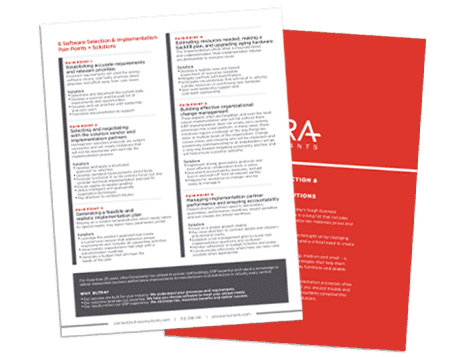5 Surprisingly Common ERP Selection Issues
The Ultra ERP Blog keeps pace with enterprise software market activity – especially as it relates to ERP selection and enterprise software implementation.
This guest post looks at issues manufacturers can run into with ERP selection.
Is it time to select a new ERP system? You are looking for one that will meet all your needs, be easy to implement, accepted by all right from the start, and provide a return that makes you a hero and helps your business succeed. ERP selection should be easy, right?
Issue #1: Not starting with business objectives
What do you hope to accomplish? What demands are your customers placing on you? What problems need to be solved? Will a new ERP system solve those issues? How will a new ERP system solve those issues? ERP is nothing more than a tool that might be able to get you where you want to go. It is a very powerful tool but it cannot solve every problem.
Make lists of what you hope to accomplish and what are the barriers to achieving those accomplishments. Prioritize the objectives. Monetize the objectives. Make this a large-scale enterprise-wide team effort. Your objective might not be another person’s. Neither of you might be targeting your organization’s objectives.
As a starting point, increasing efficiency, replacing outdated legacy systems, and gaining greater functionality were the top three reasons businesses chose to implement their ERP. Spend as much time on this phase as necessary. Unless you get this part right, you could doom any efforts to select and implement any ERP.
Next, look at the objectives and determine how or if an ERP system can help get you there. Look too at your current ERP and other tools you already have. How can you use any of these to get toward your objectives?
The gaps left behind are why you need to consider an ERP. Understanding those gaps and how ERP can resolve them is critical. Some of these are must-have and others are nice to have. Knowing that your ERP selection takes care of all the must-have needs and many of the nice to have needs will eliminate many problems others have with ERP selection. It meets the must-have needs or it doesn’t. Real simple.
Issue #2: Delaying process improvements
Do you re-engineer processes before your ERP selection or after? Often there is no absolute right answer; you could succeed either way. Process re-engineering can be more valuable to meeting your objectives than the ERP system itself. If the re-engineered process depends on the features of the new ERP, you might think you have no choice. But look carefully and maybe there is some part of the process change that could begin immediately with your current tools.
You are in business to make money. If your goal is to make $100 after selecting and implementing an ERP but you could make $75 right now by changing some processes, why wait?
Process re-engineering and ERP implementation can both be large, complex projects. Try to keep them separate. Work on one at a time and get it done before disrupting the business with a second project.
Issue #3: Delaying change management
This isn’t directly a part of ERP selection, but change management is one of the key reasons why an ERP project might fail. Whatever ERP you select, you don’t want to plan to fail.
Change is about people. People learning a new way to get their jobs done and embodying that new way so deeply that when a crisis comes along, they automatically use the new ways and do not return to the old process they once were comfortable with.
People will change how they do their jobs. Some will change easily and others not so easily. Few will simply never change. They have to know why the change is important to the company. They have to know even more so why the change is important to them. We all ask, “What’s in it for me?” That answer has to be crystal clear to each and everyone involved. Even then, they must be competently trained and have confidence that the other people upstream and downstream from them in the process flow will use the new processes too.
Issue #4: Not considering current resources
You might decide that Brand X ERP meets all your must-have objectives and more of the nice-to-have ones than any other ERP. You could also find that Brand Y also meets all the must-haves and nearly as many nice-to-haves but can be implemented with the resources you already have.
Project management is a resource you cannot succeed without. Less-visible resource needs are IT people to manage data conversion. Resource needs can also be hardware and ancillary software needed to fully implement the ERP you select. People’s time for testing the ERP, training in the ERP and new processes is very important. Will you pay overtime? Can you avoid some tasks those people currently do? Do you have available time now because of a decline in your order bookings?
Issue #5: Personal bias
You need a new ERP and you understand the priority of needs that an ERP must meet. You might have used a particular ERP at a previous job. You might have even worked for the ERP vendor. Sure, you are comfortable with that product. Don’t let your personal bias interfere with selecting the best product for your business and its needs. This is subtle. It requires stepping outside of yourself. Do it.
None of this ensures you will have no problems with ERP selection, but this preparation ahead of the selection will greatly help you make the best choice.
 Tom Miller is a columnist for ERP Focus, and has completed implementations of Epicor, SAP, QAD, and Micro MRP. He works as a logistics and supply chain manager and he always looks for processes to improve.
Tom Miller is a columnist for ERP Focus, and has completed implementations of Epicor, SAP, QAD, and Micro MRP. He works as a logistics and supply chain manager and he always looks for processes to improve.
Software selection and implementation processes often present challenges of their own. To steer you around trouble and help you drive success, Ultra’s experts compiled a list of pain points and solutions to be aware of as you embark on this journey.







